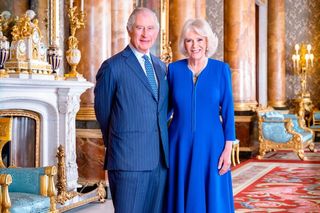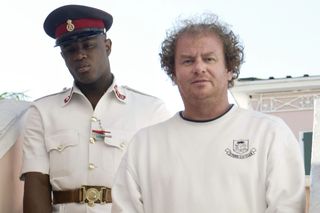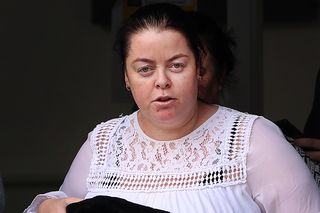Serbia school massacre: Student shooter (13) who killed nine had a list of classmates to ‘liquidate’
Teen cannot face criminal charges due to his young age
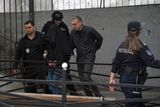
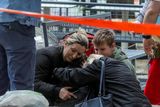
A 13-year-old who opened fire yesterday at his school in Serbia’s capital drew sketches of classrooms and made a list of people he intended to target in a meticulously planned attack, police said.
He killed eight fellow students and a guard before calling the police and being arrested.
Police identified the shooter as Kosta Kecmanovic (13), who attended the Vladislav Ribnikar school, where students would typically range in age from six to 15.
Because he is under 14, Kecmanovic cannot face criminal charges, the Belgrade prosecutor’s office said.
Serbian president Aleksandar Vucic said the boy will be placed in a psychiatric institution. Mr Vucic said that both the boy’s mother and the father had been arrested.
“As of this moment the boy is in a special place and he will be placed in a special department of a psychiatric clinic,” Mr Vucic told reporters
He carried two guns belonging to his father – at least one a handgun – and four Molotov cocktails, officials said.
Interior minister Bratislav Gasic said the weapons were licensed to his father and kept in a safe, but the teenager, who had been to shooting ranges, apparently knew the code. It is not clear how many rounds were fired, but police said the shooter reloaded the handgun.
In addition to the nine people killed, six children and a teacher were also hospitalised.
The shooter first killed a school guard and then three students in a hallway, according to senior police official Veselin Milic.
He then entered a history classroom that was close to the school entrance and opened fire again, Mr Milic said.
The assailant called police himself when the attack at the school in central Belgrade was over, though authorities had received a call reporting the shooting two minutes earlier.
A father of a student said the shooter entered his daughter’s classroom, firing at her teacher and then her classmates as they ducked under their desks.
Most students at the school were able to flee through a back door.
While Mr Milic said the shooter planned the attack for a month, sketching classrooms and writing out a list of children he planned to “liquidate”, authorities said they did not know the motive for shooting.
It was unclear if he shot any of the people on his list.
The rarity of such attacks added to the shock many felt. Commentators on television and officials repeatedly said it was the kind of thing they expected to read about elsewhere, particularly in the United States.
In the country’s last mass shooting in 2013, a Balkan war veteran killed 13 people, including family members and neighbours, in a central Serbian village.
Authorities declared three days of nationwide mourning, starting tomorrow.
Local media footage showed a commotion as police removed Kecmanovic, whose head was covered as officers led him to a car. Police sealed off the blocks around the school. Authorities later carried body bags to a waiting van.
Police said they received a call about the shooting at around 8:40 a.m. on the first day that classes resumed after a long weekend for the May 1 holiday.
“I was able to hear the shooting. It was nonstop,” said a student who was in a sports class when gunfire erupted elsewhere in the building.
Her mother asked that her name be withheld because of her age.
“I didn’t know what was happening. We were receiving some messages on the phone,” she said.
The student described the shooter as a “quiet guy” who had good grades.
“He was not so open with everybody. Surely I wasn’t expecting this to happen,” she said.
Milan Milosevic, who said his daughter was in a history class when the shooting took place, told N1 television that he rushed to the school when he heard what had happened.
He received a call from his daughter who had escaped the building and was unharmed.
“He [the shooter] fired first at the teacher and then the children who ducked under the desks,” Mr Milosevic said his daughter told him.
Milan Nedeljkovic, the mayor of the Belgrade area of Vracar, where the shooting happened, said most of the students were removed from the school through a back door.
“We have video surveillance, but now this is a lesson, we need metal detectors too. It is a huge tragedy, something like this (happening) in Belgrade. Such a tragedy at an elementary school,” he said.
Four students and a teacher were sent to University hospital, according to the hospital’s director, who said one child and the teacher were in serious condition.
While such attacks are rare, experts have repeatedly warned of the danger posed by the number of weapons in a highly divided country, where convicted war criminals are glorified and violence against minority groups often goes unpunished.
They also note that decades of instability stemming from the conflicts of the 1990s as well as the ongoing economic hardship could trigger such outbursts.
Luka Babic, a former student at Vladislav Ribnikar, bemoaned a culture of violence.
“We can’t put the blame on this school, or its teachers. It’s a tragedy of a society that promotes violence,” Mr Babic said.
“We live in the society of violence, and its been promoted in media, in public space, on social media.”
Education minister Branko Ruzic, however, was quick to blame “the cancerous, pernicious influence of the internet, video games, so-called western values”.
Such criticism is common among government officials in Serbia, where pro-Russian and anti-western sentiment have increased in recent years.
Mass shootings are extremely rare in the Balkan region, although Serbia is awash in guns left over from the wars of the 1990s.
No mass shootings have been reported at Serbian schools in recent years.



